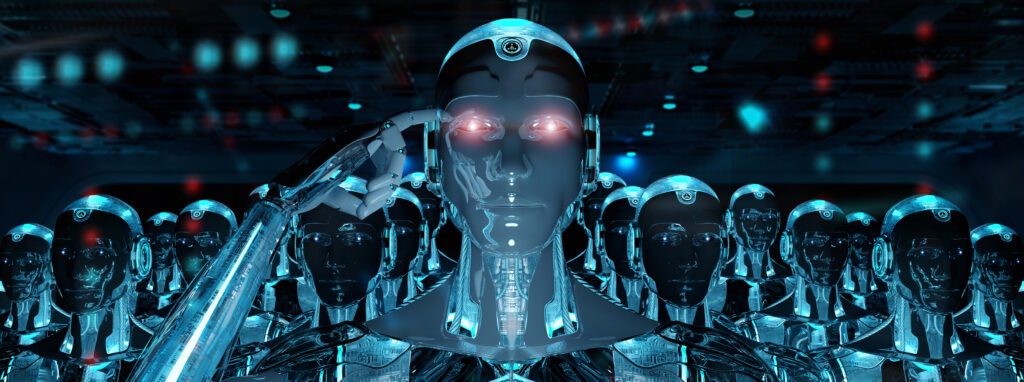Last month, Elon Musk sat on a Tesla earnings call and said the quiet part out loud. While discussing his demand for a $1 trillion compensation package, he asked investors a simple question that probably should have alarmed more people than it did.
“If we build this robot army, do I have at least a strong influence over this robot army?”
Robot army. He said it twice. Not “fleet of helpful assistants” or “workforce automation solution” but army, the word you use when you’re talking about organized forces designed for coordinated action. And he wasn’t alone in his choice of language.
When the Sci-Fi Warnings Became Product Launches
Earlier this month, a video emerged from China that looked like it was ripped straight from the opening scene of a dystopian thriller. Hundreds of humanoid robots from UBTECH Robotics stood in perfect military formation inside a massive warehouse, removing and reinserting their own battery packs before marching in synchronized lockstep toward waiting trucks.
The drone footage was so unnervingly perfect that competitors accused UBTECH of faking it with CGI. Figure AI’s CEO Brett Adcock publicly claimed the “robot army” was entirely digital, pointing to suspicious light reflections on the robots’ heads as proof. UBTECH fired back with additional footage to prove authenticity, essentially saying: no, this is real, and yes, we just shipped hundreds of them to major manufacturers including BYD, Geely, and Foxconn.
The company called it “the world’s first mass delivery of humanoid robots.” These Walker S2 units can swap their own batteries and operate 24/7 without human intervention. They’re already working on factory floors across China, and UBTECH plans to deliver 500 units by year’s end, scaling to 10,000 in 2026.
The internet had feelings. Social media exploded with comparisons to every robot uprising movie ever made, fears about mass unemployment, and genuine unease about watching hundreds of autonomous machines move with military precision. One thing everyone agreed on; whether the video was impressive or terrifying depended entirely on your level of optimism about the future.
The Real Race Nobody’s Talking About
Tesla’s Optimus program has become central to Musk’s vision for the company’s future. He’s claimed that 80% of Tesla’s value will eventually come from Optimus and related AI businesses, essentially announcing that Tesla is pivoting from cars to physical AI. The compensation package shareholders approved on November 6 hinges partially on deploying one million Optimus robots.
Musk has made wild promises about what these robots will do. They’ll perform surgery better than doctors, he’s suggested. They’ll follow convicted criminals around to prevent them “from doing crime” again, eliminating the need for prisons. They’ll colonize Mars. Working will become optional, “like growing your own vegetables instead of buying them from the store.”
The reality is far less sci-fi. Tesla has struggled with production headwinds and fallen far behind its stated goals. Musk claimed Tesla would build 5,000 units in 2025; they’re not close. Videos show Optimus serving popcorn at Tesla’s Hollywood diner and folding t-shirts, but observers note these demonstrations often rely heavily on teleoperation rather than true autonomy.
Still, the ambition is undeniable. Tesla aims to produce prototypes of Optimus Gen 3 by year’s end, with full production in early 2026. The target is one million units per year within five years, priced between $20,000 and $30,000.
Everyone Wants a Piece of the Army

It’s not just Tesla and China. The auto industry has decided that humanoid robots are the next logical step after electric vehicles. The reasoning is straightforward: robots need the same batteries, sensors, chips, and AI that automakers have already invested billions developing for autonomous cars. Add arms and legs, and you’ve essentially got a robot.
Rivian just announced a robotics spin-off called Mind Robotics. Hyundai bought Boston Dynamics a few years ago and already has robot dogs inspecting cars at U.S. plants. China’s XPeng recently unveiled its own humanoid robots. Even companies outside the auto industry are jumping in; the humanoid robotics market is expected to explode from under $2 billion in 2024 to potentially $188 billion by 2034.
The technology is real, even if the timeline is wildly optimistic. These companies have prototypes that walk, grip objects, and perform basic tasks. They have manufacturing facilities ramping up production. They have billion-dollar order books and partnerships with major industrial players.
The Part Where This Gets Uncomfortable
Musk’s use of “army” wasn’t a slip. He repeated it deliberately while explaining why he needs near-total control over Tesla. These aren’t just products; they’re assets that confer power.
China understands this. Their push into humanoid robotics is about establishing dominance in a technology that will reshape manufacturing and logistics. The viral video wasn’t an accident. It was a statement.
If these companies succeed, we’re talking about millions of humanoid robots working 24/7, learning from each other, replacing human labor at scale. The promises are seductive: economic abundance, freedom from dangerous work, a future where humans focus on creative pursuits. But those promises require trusting that companies building “armies” will prioritize human welfare over profit.
Musk asked if he’d have “strong influence” over his robot army. Shareholders said yes. China is already deploying theirs. The race is on, and whether this looks more like utopia or dystopia depends on decisions being made right now in boardrooms most of us will never see.
The robots are coming. The only question is whose army you’ll be living alongside.

